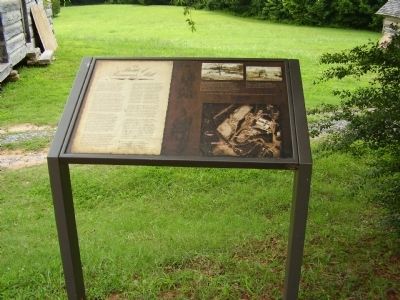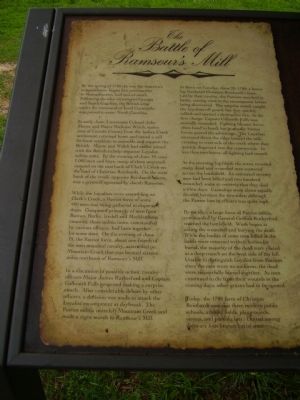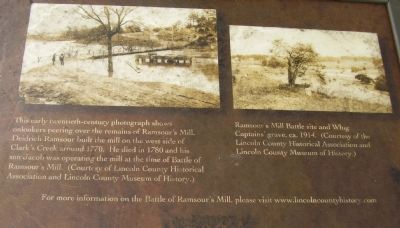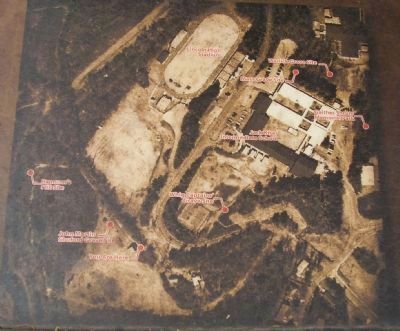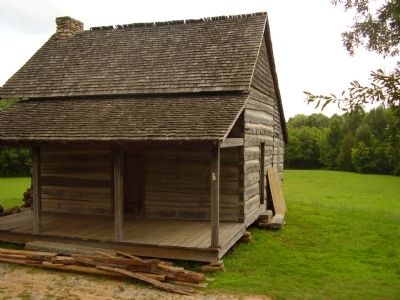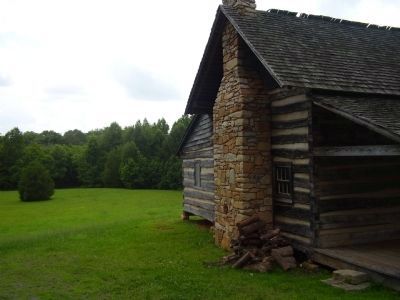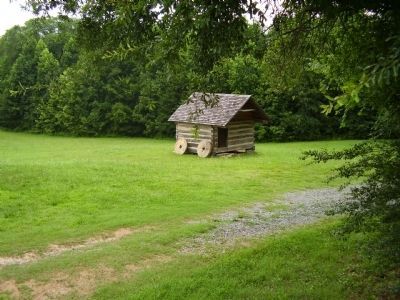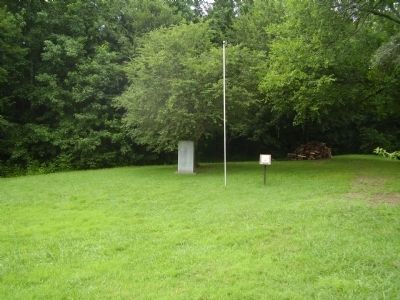Lincolnton in Lincoln County, North Carolina — The American South (South Atlantic)
The Battle of Ramsour's Mill
In early June, Lieutenant Colonel John Moore and Major Nicholas Welch, native sons of Lincoln County from the Indian Creek settlement, returned home and issued a call for local residents to assemble and support the British. Moore and Welch had earlier joined with the British to help organize Loyalist militia units. By the evening of June 19, over 1,000 men and boys, many of them unarmed, camped on the east bank of Clark's Creek on the land of Christian Reinhardt. On the west bank of the creek, opposite Reinhardt's farm, was a gristmill operated by Jacob Ramsour.
While the Loyalists were assembling on Clark's Creek, a Patriot force of some 400 men was being gathered to disperse them. Composed primarily of men from Rowan, Burke, Iredell and Mecklenburg counties, these militia units, commanded by various officers, had been together for some time. On the evening of June 19, the Patriot force, about one-fourth of the men mounted cavalry, assembled on Mountain Creek that was located sixteen miles northeast of Ramsour's Mill.
In a discussion of possible action, cavalry officers Major James Rutherford and Captain Galbraith Falls proposed making a surprise attack. After considerable debate by other officers, a decision was made to attack the Loyalist encampment at daybreak. The Patriot militia units left Mountain Creek and made a night march to Ramsour's Mill.
At dawn on Tuesday, June 20, 1780, a heavy fog blanketed Christian Reinhardt's farm. Led by their cavalry, the Patriots marched to battle, coming close to the encampment before being discovered. The surprise attack caught the Loyalists off guard, but they quickly rallied and opened a destructive fire. In the first charge, Captain Gilbraith Falls was mortally wounded. Fighting became fierce, often hand to hand, but gradually Patriot forces gained the advantage. The Loyalists retreated down the ridge toward the mill, crossing to the west side of the creek where they quickly dispersed into the countryside. In less than two hours, all fighting had ceased.
As the morning fog lifted, the scene revealed many dead and wounded men scattered across the battlefield. An estimated seventy men had been killed and two hundred wounded, some so severely that they died within days. Casualties were about equally divided between the two sides, although the Patriot loss in officers was quite high.
By midday, a large force of Patriot militia commanded by General Griffith Rutherford reached the battlefield. Work began at aiding the wounded and burying the dead. While bodies of some men killed in the battle were returned to their homes for burial, the majority of the dead were placed in a deep trench on the west side of the hill. Unable to distinguish Loyalist from Patriots since the men wore no uniforms, the dead were respectfully buried together. As men continued to die from their wounds in the coming days, other graves had to be opened.
Today, the 1780 farm of Christian Reinhardt contains three modern public schools, athletic fields, playgrounds, streets, and parking lots. Dotted among them are four known burial sites.
Erected by Lincoln County Historical Association.
Topics. This historical marker is listed in these topic lists: Cemeteries & Burial Sites • War, US Revolutionary. A significant historical year for this entry is 1780.
Location. 35° 28.607′ N, 81° 15.96′ W. Marker is in Lincolnton, North Carolina, in Lincoln County. Marker can be reached from Jeb Seagle Drive, 0.2 miles north of Linwood Drive, on the left when traveling north. Touch for map. Marker is in this post office area: Lincolnton NC 28092, United States of America. Touch for directions.
Other nearby markers. At least 8 other markers are within walking distance of this marker. War Comes to North Carolina's Backcountry (here, next to this marker); The Battle (a few steps from this marker); The Aftermath (a few steps from this marker); The John Martin Shuford Gravesite (within shouting distance of this marker); The Patriot Captains' Gravesite (about 600 feet away, measured in a direct line); Ramsour-Reinhardt Cemetery (approx. 0.4 miles away); a different marker also named Battle of Ramsour's Mill (approx. 0.4 miles away); Michael Hoke (approx. half a mile away). Touch for a list and map of all markers in Lincolnton.
More about this marker. On the upper right is a photograph with the caption, "This early twentieth-century photograph shows onlookers peering over the remains of Ramsour's Mill. Deidrich Ramsour built the mill on the west side of Clark's Creek around 1770. He died in 1780 and his son Jacob was operating the mill at the time of the Battle of Ramsour's Mill. (Courtesy of Lincoln County Historical Association and Lincoln County Museum of History.)
On the upper right is a photograph with the caption, "Ramsour's Mill Battle site and Whig Captains' grave, ca. 1914. (Courtesy of the Lincoln County Historical Association and Lincoln County Museum of History.)
On the lower right is an aerial photograph showing the location Ramsour's Mill and the four known burial sites.
Credits. This page was last revised on March 9, 2021. It was originally submitted on July 10, 2011, by Stanley and Terrie Howard of Greer, South Carolina. This page has been viewed 1,321 times since then and 49 times this year. Photos: 1, 2, 3, 4, 5, 6, 7, 8. submitted on July 10, 2011, by Stanley and Terrie Howard of Greer, South Carolina. • Bernard Fisher was the editor who published this page.
